Art Is Whatever a Society or a Culture Determines Is Art.
The importance of art is an of import topic and has been debated for many years. Some might think art is not as important as other disciplines similar science or technology. Some might enquire what fine art is able to offer the world in terms of evolution in culture and society, or perhaps how can art change us and the globe. This article aims to explore these weighty questions and more. Then, why is art important to our culture? Let us take a expect.
Table of Contents
- 1 What Is Art?
- i.i The Definition of Fine art
- 1.2 The Types and Genres of Art
- 2 Top Reasons for the Importance of Fine art
- 2.one Art Is a Universal Language
- 2.2 Fine art Allows for Self-Expression
- 2.3 Art Keeps Track of History and Culture
- 2.4 Art Assists in Pedagogy and Human Development
- 2.v Art Adds Dazzler for Art's Sake
- 2.half-dozen Art Is Socially and Financially Rewarding
- 2.vii Art Is a Powerful (Political) Tool
- iii Art Will Always Be There
- 4 Ofttimes Asked Questions
- iv.1 What Is the Importance of Arts?
- 4.2 Why Is Art Important to Culture?
- iv.3 What Are the Dissimilar Types of Fine art?
- iv.4 What Is the Definition of Art?
What Is Art?
There is no logical answer when nosotros ponder the importance of arts. Information technology is, instead, molded past centuries upon centuries of creation and philosophical ideas and concepts. These non only shaped and informed the way people did things, but they inspired people to do things and live certain ways.
We could even get so far every bit to say the importance of art is borne from the very act of making art. In other words, it is formulated from abstract ideas, which then plow into the action of creating something (designated equally "fine art", although this is also a contested topic). This then evokes an impetus or move within the human individual.
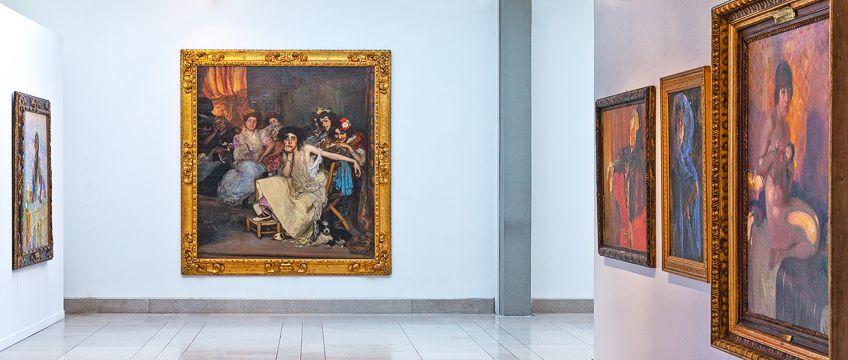 The department on mod art in the Rivoltella Museum, Trieste, Italy
The department on mod art in the Rivoltella Museum, Trieste, Italy
This impetus or movement can exist anything from stirred up emotions, crying, feeling inspired, didactics, the sheer pleasance of aesthetics, or the unproblematic convenience of functional household items – every bit we said before, the importance of fine art does not have a logical answer.
Earlier we go deeper into this question and concept, we need some context. Below, we wait at some definitions of fine art to help shape our understanding of fine art and what it is for us as humans, thus allowing united states to meliorate empathize its importance.
The Definition of Art
Simply put, the definition of the word "art" originates from the Latin ars or artem, which means "skill", "craft", "work of art", among other similar descriptions. According to Merriam-Webster's online dictionary, the discussion has diverse meanings; art may be a "skill acquired past experience, study, or observation", a "branch of learning", "an occupation requiring knowledge or skill", or "the conscious utilize of skill and artistic imagination especially in the production of artful objects".
We might also tend to think of fine art in terms of the latter definition provided above, "the conscious utilize of skill" in the "production of artful objects". Even so, does art only serve artful purposes? That volition too depend on what art means to the states personally, and not how information technology is collectively divers. If a painting done with smashing skill is considered to be art, would a slice of article of furniture that is also fabricated with great skill receive the same label as being art?
Thus, art is defined by our very ain perceptions.
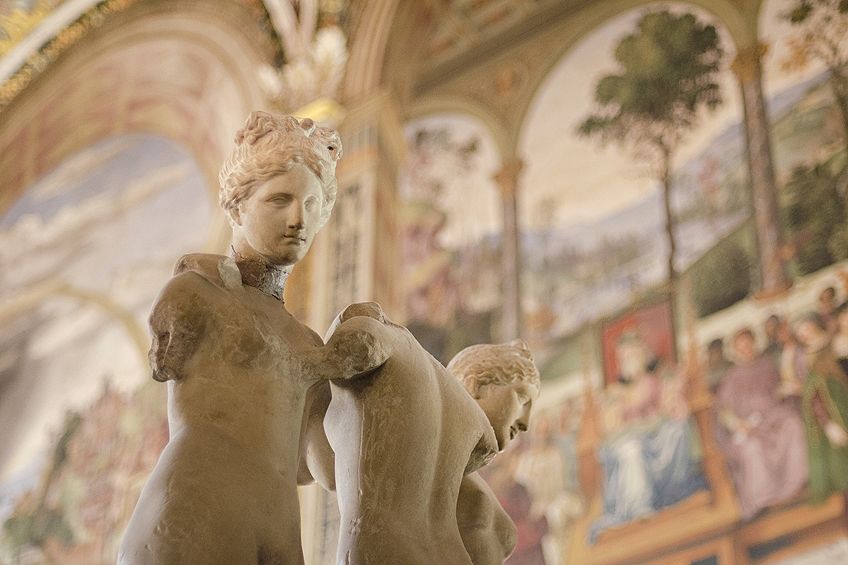
Art has also been molded by different definitions throughout history. When we look at it during the Classical or Renaissance periods, it was very much defined by a set of rules, peculiarly through the various art academies in the major European regions like Italy (Academy and Company for the Arts of Drawing in Florence), French republic (French Academy of Fine Arts), and England (Imperial Academy of Arts in London).
In other words, art had an bookish component to information technology and so every bit to distinguish artists from craftsmen.
The defining factor has ever been between art for art's sake, art for aesthetic purposes, and art that serves a purpose or a function, which is besides referred to as "utilitarianism". It was during the Classical and Renaissance periods that fine art was defined according to these various predetermined rules, merely that leaves united states of america with the question of whether these so-called rules are able to illustrate the deeper meaning of what fine art is?
If nosotros move forward in time to the 20thursday century and the more than mod periods of art history, we find ourselves amid a whole new art world. People have inverse considerably between at present and the Renaissance era, but we can count on fine art to be like a trusted friend, reflecting and expressing what is inherent in the cultures and people of the time.

During the 20th century, art was non confined to rules like perspective, symmetry, religious subject area matter, or only certain types of media similar oil paints. Art was freed, then to say, and we see the definition of it changing (literally) in front end of our very own optics over a multifariousness of canvases and objects. Art movements like Cubism, Fauvism, Dadaism, and Surrealism, among others, facilitated this newfound freedom in art.
Artists no longer subscribed to a set of rules and created fine art from a more subjective vantage point.
Additionally, more resources became available across only pigment, and artists were able to explore new methods and techniques previously not available. This undoubtedly inverse the preconceived notions of what art was. Art became commercialized, aestheticized, and devoid of the traditional Classical significant from earlier. Nosotros tin can meet this in other art movements like Popular Art and Abstract Expressionism, among others.
The Types and Genres of Art
There are also different types and genres of art, and all have had their own evolution in terms of beingness classified every bit fine art. These are the fine arts, consisting of painting, drawing, sculpting, and printmaking; applied arts like compages; as well as different forms of design such equally interior, graphic, and way design, which give twenty-four hour period-to-day objects aesthetic value.
Other types of fine art include more decorative or ornamental pieces like ceramics, pottery, jewelry, mosaics, metalwork, woodwork, and fabrics like textiles. Performance arts involve theater and drama, music, and other forms of motion-based modalities similar dancing, for example. Lastly, Plastic arts include works made with different materials that are pliable and able to exist formed into the subject matter, thus becoming a more than easily-on approach with 3-dimensional interaction.
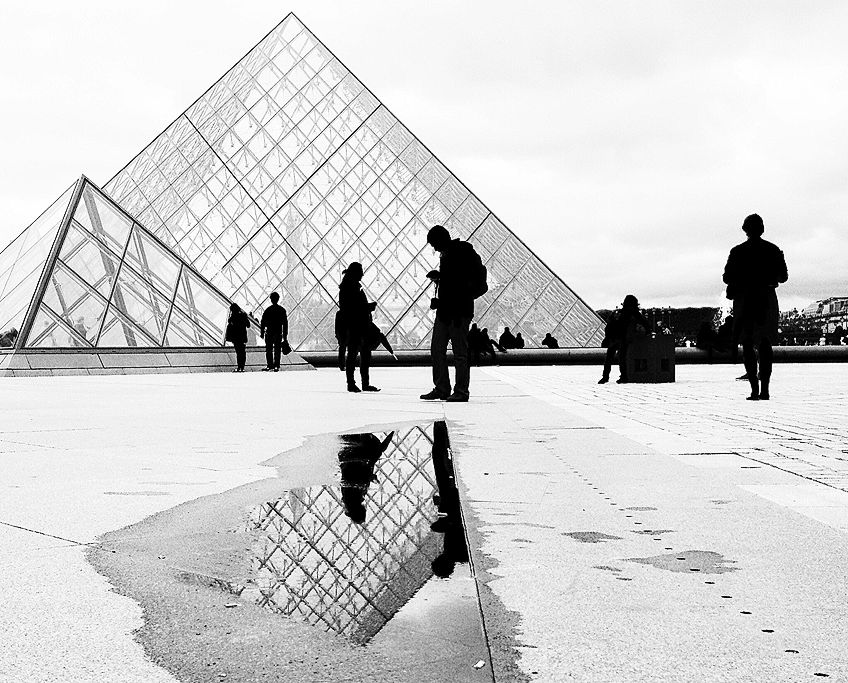 The Louvre Museum in Paris, French republic
The Louvre Museum in Paris, French republic
Tiptop Reasons for the Importance of Art
Now that nosotros have a reasonable understanding of what art is, and a definition that is ironically undefinable due to the ever-evolving and fluid nature of art, we can expect at how the art that we have come to understand is of import to culture and society. Below, we will outline some of the elevation reasons for the importance of fine art.
Art Is a Universal Language
Art does not need to explain in words how someone feels – it only shows. Almost anyone can create something that conveys a message on a personal or public level, whether it is political, social, cultural, historical, religious, or completely void of whatever message or purpose. Art becomes a universal linguistic communication for all of u.s.a. to tell our stories; it is the ultimate storyteller.
Nosotros can tell our stories through paintings, songs, poesy, and many other modalities.

Art connects us with others likewise. Whenever we view a specific artwork, which was painted past a person with a particular idea in mind, the viewer volition feel or remember a certain style, which is informed by the artwork (and artist's) message. As a result, art becomes a universal language used to speak, paint, perform, or build that goes beyond different cultures, religions, ethnicities, or languages. It touches the deepest aspects of being human, which is something we all share.
Art Allows for Self-Expression
Touching on the above indicate, art touches the deepest aspects of beingness man and allows us to express these deeper aspects when words fail u.s.a.. Art becomes like a best friend, giving us the freedom and space to be creative and explore our talents, gifts, and abilities. It tin can also assist us when we demand to limited difficult emotions and feelings or when we demand mental clarity – it gives us an outlet.
Fine art is widely utilized as a therapeutic tool for many people and is an of import vehicle to maintain mental and emotional wellness. Art likewise allows us to create something new that will add value to the lives of others. Consistently expressing ourselves through a chosen art modality will also enable us to get more than adept and disciplined in our skills.
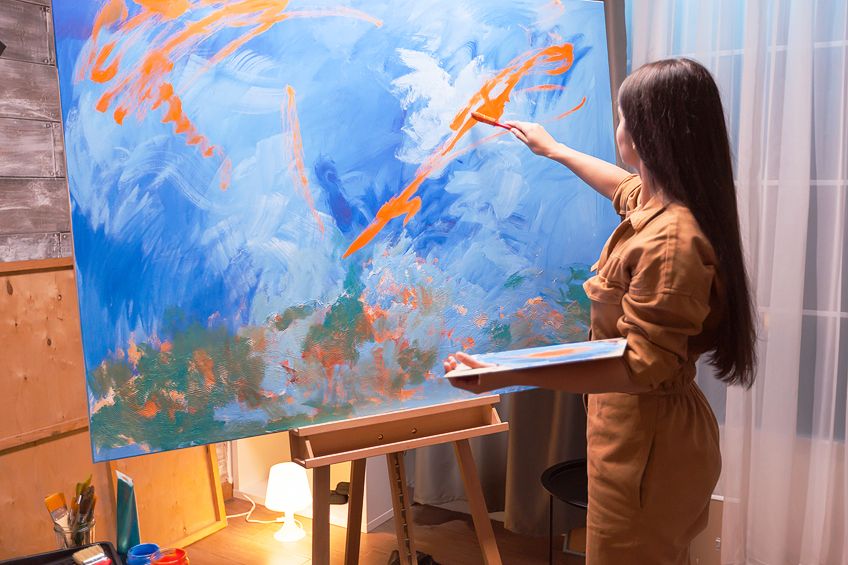
Art Keeps Rail of History and Culture
We might wonder, why is art of import to culture? As a universal language and an expression of our deepest man nature, art has ever been the go-to to go along runway of everyday events, almost like a visual diary. From the geometric motifs and animals establish in early prehistoric cave paintings to portrait paintings from the Renaissance, every artwork is a modest window into the ways of life of people from various periods in history. Art connects us with our ancestors and lineage.
When nosotros find unlike artifacts from all over the world, we are shown how different cultures lived thousands of years ago. We can go along track of our current cultural trends and learn from past societal challenges. We can draw inspiration from past art and artifacts and in turn, create new forms of art.
Art is both timeless and a testament to the dissimilar times in our history.
Art Assists in Education and Human being Development
Art helps with human development in terms of learning and understanding difficult concepts, equally it accesses different parts of the human brain. Information technology allows people to problem-solve likewise as make more than circuitous concepts easier to understand by providing a visual format instead of merely words or numbers. Other areas that art assists learners in (range from children to adults) are the development of motor skills, critical thinking, inventiveness, social skills, as well as the ability to retrieve from dissimilar perspectives.
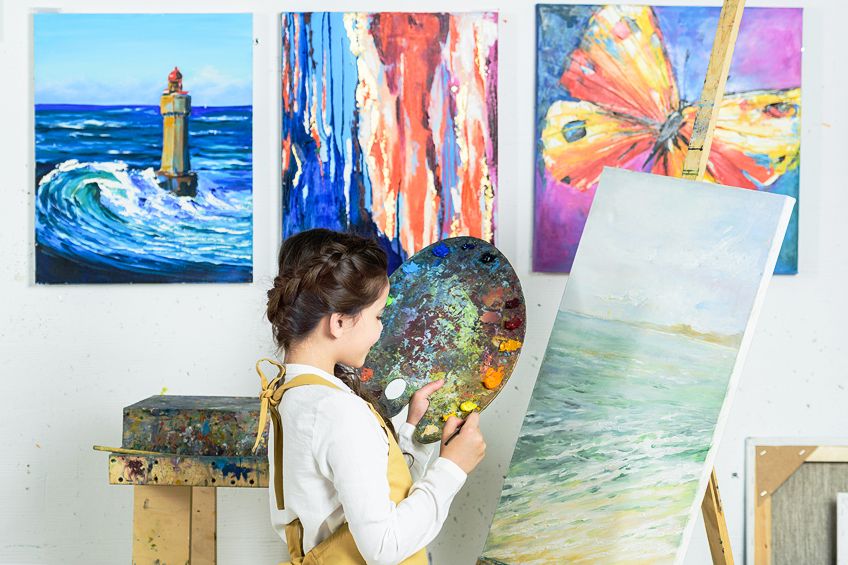
Art subjects will also help students ameliorate on other subjects similar maths or science. Diverse enquiry states the positive effects art has on students in public schools – it increases discipline and attendance and decreases the level of unruly behavior.
According to resource and questions asked to students about how art benefits them, they reported that they look forward to their art lesson more all their other lessons during their school day. Additionally, others dislike the structured format of their school days, and art allows for more than creativity and expression away from all the rules. Information technology makes students feel costless to do and be themselves.
Fine art Adds Beauty for Art's Sake
Fine art is versatile. Non merely can information technology help u.s. in terms of more complex emotional and mental challenges and enhance our well-existence, only it can also simply add beauty to our lives. Information technology tin be used in numerous ways to make spaces and areas visually appealing.
When we wait at something cute, nosotros immediately experience better. A slice of fine art in a room or office tin either create a sense of calm and peace or a sense of motility and dynamism.
Art tin can elevator a space either through a painting on a wall, a slice of colorful article of furniture, a sculpture, an ornamental object, or even the whole building itself, every bit we see from so many examples in the world of architecture. Sometimes, art can exist just for art's sake.

Art Is Socially and Financially Rewarding
Art can be socially and financially rewarding in then many means. Information technology tin become a profession where artists of varying modalities tin can earn an income doing what they honey. In turn, it becomes part of the economic system. If artists sell their works, whether in an art gallery, a park, or online, this will attract more than people to their location. Thus, information technology could even become a beacon for improved tourism to a metropolis or country.
The best examples are cities in Europe where there are numerous art galleries and architectural landmarks celebrating artists from dissimilar periods in art history, from Gothic cathedrals similar the Notre Dame in Paris to the Vincent van Gogh Museum in Amsterdam. Art can also encourage people to do exercise by hiking up mountains to visit pre-celebrated rock art caves.
Fine art Is a Powerful (Political) Tool
Knowing that art is so versatile, that it can be our all-time friend and teacher, makes information technology a very powerful tool. The history of humankind gives united states of america thousands of examples that show how art has been used in the hands of people who mean well and people who practice not mean well.
Therefore, understanding the role of art in our lives every bit a powerful tool gives usa a stiff indication of its importance.
Art is also used as a political medium. Examples include memorials to celebrate pregnant changemakers in our history, and conveying powerful messages to society in the form of posters, banners, murals, and fifty-fifty graffiti. Information technology has been used throughout history by those who have rebelled as well equally those who created propaganda to bear witness the world their intentions, as farthermost as wanting to take over the world or disrupt existing regimes.
 "Relieve Human Lives" poster stamps reproducing details from iv different Arthur Szyk artworks, including Tears of Rage, To Be Shot as Dangerous Enemies of the 3rd Reich, and Modern Moses, 1944;Arthur Szyk, CC BY-SA 4.0, via Wikimedia Commons
"Relieve Human Lives" poster stamps reproducing details from iv different Arthur Szyk artworks, including Tears of Rage, To Be Shot as Dangerous Enemies of the 3rd Reich, and Modern Moses, 1944;Arthur Szyk, CC BY-SA 4.0, via Wikimedia Commons
The Futurist art motility is an example of art combined with a group of men who sought to change the manner of the time to come, informed by meaning changes in society like the industrial revolution. Information technology likewise became a mode of expression of the political stances of its members.
Other movements like Constructivism and Suprematism used fine art to convey socialist ideals, also referred to as Socialist Realism.
Other artists like Jacques-Louis David from the Neoclassical motility produced paintings influenced by political events; the bailiwick thing also included themes similar patriotism. Other artists include Pablo Picasso and his famous oil painting, Guernica (1937), which is a symbol and apologue intended to reach people with its message.
The to a higher place examples all illustrate to us that various wars, conflicts, and revolutions throughout history, notably Globe Wars I and II, accept influenced both men and women to produce art that either celebrates or instigates changes in society. The power of art's visual and symbolic impact has been able to convey and entreatment to the masses.
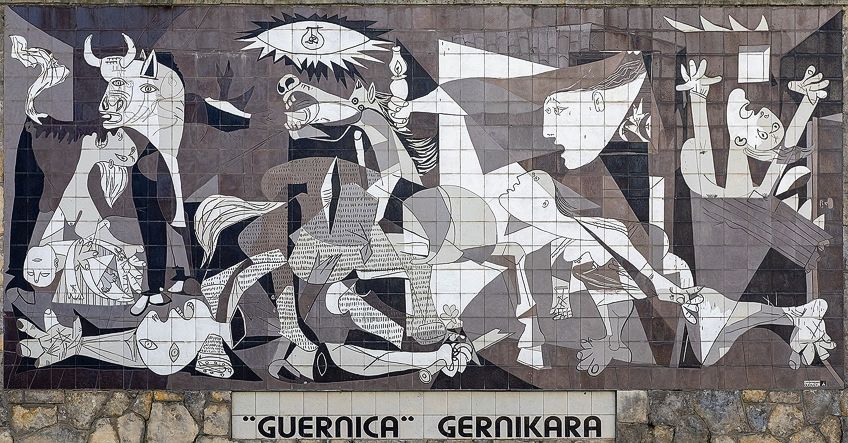 Mural of the painting Guernica by Picasso, made in tiles and full-sized, located in Guernica, Espana;Jules Verne Times Two / world wide web.julesvernex2.com, CC By-SA 4.0, via Wikimedia Commons
Mural of the painting Guernica by Picasso, made in tiles and full-sized, located in Guernica, Espana;Jules Verne Times Two / world wide web.julesvernex2.com, CC By-SA 4.0, via Wikimedia Commons
Art Will Always Be There
The importance of fine art is an easy concept to understand considering there are and so many reasons that explain its benefits in our lives. We do not have to expect too hard to determine its importance. We can likewise examination it on our lives past the effects it has on how nosotros feel and think when nosotros engage with it every bit onlookers or equally active participants – whether it is painting, sculpting, or continuing in an art gallery.
What art continuously shows usa is that information technology is a constant in our lives, our cultures, and the globe. It has always been there to help us in self-expression and telling our story in any manner we desire to. It has also given us glimpses of other cultures along the style.
Art is fluid and versatile, only similar a piece of clay that tin exist molded into a beautiful bowl or a slab of marble carved into a statue. Art is besides a powerful tool that tin can exist used for the skilful of humanity good or as a political weapon.
Art is important considering information technology gives us the power to mold and shape our lives and experiences. It allows united states to answer to our circumstances on micro- and macroscopic levels, whether information technology is to appreciate beauty, enhance our wellbeing, delve deeper into the spiritual or metaphysical, celebrate changes, or to rebel and revolt.
Take a look at our purpose of art webstory here!
Often Asked Questions
What Is the Importance of Arts?
In that location are many reasons that explicate the importance of fine art. It is a universal language considering it crosses language and cultural barriers, making it a visual language that anyone tin can understand; it helps with self-expression and self-awareness because information technology acts as a vehicle wherein we can explore our emotions and thoughts; it is a record of past cultures and history; it helps with education and developing dissimilar skill sets; it tin can be financially rewarding, information technology can be a powerful political tool, and it adds beauty and ambiance to our lives and makes usa feel good.
Why Is Art Of import to Culture?
Art is of import to civilization because it can bridge the gap betwixt different racial groups, religious groups, dialects, and ethnicities. It tin can express common values, virtues, and morals that we can all empathise and experience. Art allows the states to enquire of import questions near life and society. It allows reflection, it opens our hearts to empathy for others, as well as how we care for and chronicle to one another as human beings.
What Are the Different Types of Art?
There are many different types of art, including fine arts like painting, drawing, sculpture, and printmaking, too as applied arts similar compages, design such as interior, graphic, and fashion. Other types of art include decorative arts like ceramics, pottery, jewelry, mosaics, metalwork, woodwork, and fabrics like textiles; operation arts similar theater, music, dancing; and Plastic arts that piece of work with different pliable materials.
What Is the Definition of Art?
The definition of the word "art" originates from the Latin ars or artem, which means "skill", "arts and crafts", and a "work of fine art". The Merriam-Webster online lexicon offers several meanings, for example, art is a "skill acquired by experience, study, or observation", it is a "branch of learning", "an occupation requiring knowledge or skill", or "the conscious use of skill and artistic imagination specially in the production of aesthetic objects".
Source: https://artincontext.org/why-is-art-important/